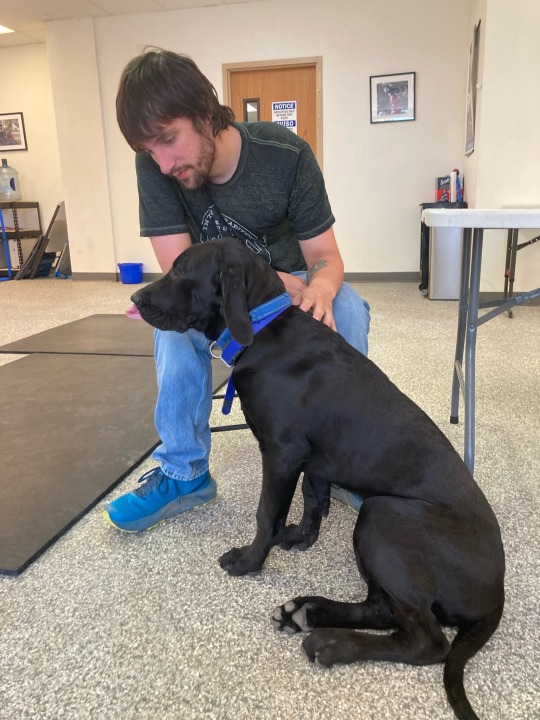Robin/Ducky / 21+ / Service Dogs yay!!! / if you want to learn about them-you’ve come to the right place! / header from Unsplash/jeswin Thomas
Don't wanna be here? Send us removal request.
Text
Here’s something we have not covered yet:
How much do service dogs really cost?
The answer is: it’s variable. It depends on what the dog is trained to do, where the dog is acquired, and how skilled you are in your own training efforts. I’m going to break down three scenarios for you to illustrate this, as well as their pros and cons. To keep things concise, I’ll do one post for each.
Scenario one: You are very familiar with dogs and how to train them, to the point you could almost be professional. After some months of searching, you’ve located a dog at a local animal shelter that has the right temperament and appears to have no major behavior or heath issues according to records. The dog is 2.5 years old so ready to jump right into training. You know lots about training but end up consulting another professional twice to make sure you are on track. By the time the dog is 3, they are task trained and ready to go.
The costs associated with this would be as follows:
Adoption cost for the dog: ~$200
Food for those six months: ~$400 (based on a larger dog eating an upper mid-tier brand)
Professional Training Sessions: ~120, x2
Gear for the dog: ~$180 for a custom harness
Other assorted toys, treats, and supplies ~$500
You are looking at a minimum of $1400 in this situation, which overall isn’t bad. However it does not account for ongoing costs or potential veterinary care
Pros:
-Less Expensive
-You get the dog when you need it
-More flexibility to familiarize the dog with your routine and their work environment
-no puppy phase
Cons:
-Finding a shelter dog can take some time
-Shelter dogs have a high failure rate due to often unknown at the time health or behavioral issues
-The dog’s career will be shorter
-The majority of people don’t have the skills needed to train the dog independently with limited guidance
1 note
·
View note
Text
More Fundraising Efforts Abound! I’m partnering with Panda Express to help raise those much needed funds to pay for service dogs, for me and others. This one is super easy too.
All you have to do is order online or via the app at any Panda Express location in the US on November 22 and enter the fundraising code: 928199
28% of all profits go back to the Every Percent Matters Foundation, a smaller group that works with my needs and rescues dogs to make it happen.

4 notes
·
View notes
Text
Today we have: Puppies!!!
Went to meet with a breeder about a potential puppy and even if it doesn’t work, they sure were adorable


21 notes
·
View notes
Text
Service dogs are granted a lot of rights under ADA and public access. But what CAN’T they do?
A big one is causing a disturbance. If a service dog is causing a disturbance in a public access location, then said dog can be asked to leave. It does not matter if the service dog is legitimate or not.
This is due to the fact a dog must be under a handler’s control at all times.
Behaviors like non-task barking, lunging, soliciting attention from people not the handler, not being potty trained, and being left unattended somewhere such as a hotel or event venue are just some examples of what you can be asked to leave for.
If a service dog is asked to leave the premise, then the handler MUST be given an option to still utilize services without the dog, and reasonable efforts should be made to provide alternate disability accommodations where possible.
Along with that, while service dogs do have public assess rights but that is not all encompassing. Specifically, service dogs are only granted rights under public access when the area involve is somewhere the general public is allowed to go.
A service dog can be barred from places where their presence could compromise overall health and safety, such as in a sterile environment.
That is the extent of access protection granted under the ADA. All other protections exist within other laws, be them state or National.
5 notes
·
View notes
Text
Looking for a service dog but don’t know where to start?
Check out Assistance Dogs International. They have a wealth of great resources, as well as a directory of major service dog organizations that have been thoroughly vetted to assist in your search.
1 note
·
View note
Text
FINALLY some positive pittie representation! 🐶 i've always wanted to rescue a grey faced senior pit bull breed as an emotional service dog to give some amazing sunset years to. dog friendly restaurants, the beach. artist says the service dog community can be really toxic.
"American bully as a Psych alert dog, Phalene as a Diabetic Alert, and a Labrador x golden retriever mix is Guide, representing program dogs ❤️" ~Shay Facklam 🐾

28 notes
·
View notes
Text
Common Types of Service Dogs:
-Seeing Eye aka Guide Dogs who assist their handlers by guiding them safely while out in public
-Mobility Assistance Dogs who assist handlers with a myriad of mobility related tasks such as opening doors, picking up items, and balance work
-Seizure alert dogs who alert to incoming seizures and can have post seizure response tasks to keep their handler safe
-Allergy Detection Dogs who check foods and such for specific allergens so that their handler knows food is safe to eat
-Diabetic Alert Dogs who alert to high or low blood sugars so handlers can take action, or seek help when needed dying a diabetic emergency.
-Hearing Assistance Dogs who alert deaf and HOH handlers to important sounds
-PTSD assistance dogs who help with mitigating PTSD symptoms
-Autism Assistance dogs who preform a variety of tasks to assist autistic handlers ranging from behavior interruption to overstimulation alerts
And Many More! Though these sub-types tend to be the kind you hear about or see most
7 notes
·
View notes
Text
Do service dogs have to be registered?
NO! They do not require any kind of registration. In fact, in the United States there is no official registry for service dogs.
Business are not allowed to ask for, or require papers. They don’t exist. Don’t get scammed into paying money for a registration that doesn’t hold any real power.
In fact your dog doesn’t even need to be wearing any gear that identify it as a service dog. (Though many do anyway.)
1 note
·
View note
Text

Did you know the average cost to train a service dog can be upwards of $20,000 USD?
This price tag is high due to the all of the work that goes in to selecting, caring for, and training a service dog over a period of up to 2-3 years. Unfortunately, this price tag is one of the largest barriers standing between a disabled person and the service dog they desperately need.
That’s where charity organizations and non-profits step in and help fill in the gaps.
They provide grants when possible and step in to assist individuals in fundraising the money they need in order to cover these costs.
I am not exempt from this struggle myself-so I have my own fundraiser going, in partnership with See’s Candies.
Use one of my store links to find and order your ideal treat. It’s shipped directly to you, and up to 50% of the profits are donated back to the charitable organization Every Percent Counts, which is the group backing me and my service dog journey.
Holiday Gifts:
Open 10/8-12/6
Orders ship out staring 11/11/2024
Every day Candy Goodness:
Open 10/08-1/31/2025
Can’t support the effort? No problem. Share this, that way we can reach as many interested parties as possible. The goal is to raise enough to cover my service dog. Any additional funds will be put towards grants for other service dog teams.
33 notes
·
View notes
Text
Meet Moe & Shark!
We went down today to meet these two service dog candidates. They’re rescue dogs who’ve been given a second chance at life doing critical work. Not sure if one of these lovely boys will end up my partner, but they were great to interact with!


2 notes
·
View notes
Text
So just recently I mentioned that any dog can be a service dog as long as they have the temperament. Today I want to go over the one major exception to that rule:
Mobility Service Dogs. These dogs provide an invaluable service for people. They do things such as open doors, retrieve items, help their handlers stand up or balance, provide a forward momentum pull, and counterbalancing, among other things.
Dogs who provide this type of assistance have additional requirements, since the work can put additional physical strain on the body and cause an enormous amount of stress on the body and joints for dogs not built for the work. Therefore-only specific dogs can be mobility dogs. They have to be a certain weight, have a flat and stable build, and have no hip or elbow problems.
The typical recommended ratio for these dogs for light mobility work, which typically includes everything except for for full bracing and extensive counter balance, and wheelchair pulling is typically quoted as 30% of the handlers weight and 30% of their height-so for an adult with a weight of 160lbs and a height of 5’9” would need a dog NO SMALLER than ~55lbs, with a height of 23” at the shoulder.
For Heavy mobility Tasks like bracing, extensive counterbalance, or wheelchair pulling is higher. For these you want a dog that is 50-55% of your weight and 40% of your height. So for the same hypothetical person we looked at above, you’d need a dog that is NO SMALLER than 80lbs, and ideally a height of 27” at the shoulder.
This is specially for the heath and happiness of the dog-so make sure you are very specific about breed choice and MAKE SURE that you get the okay on your dog’s joints from a vet before preforming any kind of mobility work with a dog.
Ideal breeds for small to average height/weight people (or mixes if you’re rescuing) include:
Golden Retrievers
Labrador Retrievers
German Shepherds (Working Line. Be careful with show lines as there has been issues with malformed joint and back structure in many of these)
Larger Standard Poodles (You don’t need a labradoodle or any other doodle mix to get what you need. A standard poodle is capable of preforming this work just fine as long as it meets the size requirements)
Rottweilers
“Bully Breeds” such as pitbulls or staffies. (They often meet the weight requirement but tend to be on the shorter side so keep this in mind)
Dogs ideal for larger people and/or heavy mobility:
Newfoundlands
Bernese Mountain Dogs
St. Bernard’s
Mastiff Breeds
Great Danes
#service dogs#education#faq#dogs#yes I am a poodle elitest#poodles don’t shed they are allergy friendly#they are very smart and often have the working drive needed for service work#there was no need and there never will be a need to cross them with other breeds to make them service suitable#yes I am salty about having my poodle constantly being mistaken for a mix
7 notes
·
View notes
Text
Today’s service dog post: an example!
My little assistant orca has been working on some task training and while she doesn’t quite have what it takes size or temperament wise for public access, she’s a great helper at home! In this video, I go over what I’m asking her to do and why.
5 notes
·
View notes
Text
Today’s service dog post: an example!
My little assistant orca has been working on some task training and while she doesn’t quite have what it takes size or temperament wise for public access, she’s a great helper at home! In this video, I go over what I’m asking her to do and why.
5 notes
·
View notes
Text
Are service dog and emotional support dogs the same thing?
No! They are not. Emotional support animals play an incredibly important role for a great many people but it’s important to understand the limitations. An emotional support animal has no public access rights-you can’t take it wherever you want. There are no rules dictating the training for emotional support dogs and their access is limited to pet-free housing.
The law specifically states that if an animal’s sole purpose is to provide emotional support, it does NOT qualify as a service animal as that is not considered a specific task required to mitigate a disability.
However, that doesn’t mean people with mental or emotional struggles can’t have service animals. They simply need a task on top of emotional support/comfort. Examples could include providing tactile stimulation for grounding, interrupting harmful behavior, or calming deep pressure therapy to assist with anxiety or panic episodes.
So in short: All service animals can be emotional support animals but not all emotional support animals can be service animals.
9 notes
·
View notes
Text
Where do you get a service dog anyways?
Two main options! The most commonly known one is to partner with a charity or organization that raises dogs. This is a great option for people who don’t have the time to commit to training and whose needs align with that of the organization.
But! If, for whatever reason, the organization route doesn’t work for you, you can train a dog yourself! There are no rules saying a dog has to be trained by an organization.
You can also go a third route and do a mix of profesional and self-training if going solo doesn’t fit the bill either.
As long as the dog behaves appropriately in public and is tasked trained, where it learns that is irrelevant. Training your service dog should happen however works best for you personally.
5 notes
·
View notes
Text
Can any dog be a service dog?
Yes and no. Any dog of any breed can be chosen for service dog training. Anything from a 2lbs chihuahua up to a 180lbs Great Dane could be a service dog.
Breed does not matter. What matters is temperament. Not every dog has what it takes. It takes a special dog, with focus and drive who is not easily distracted and is comfortable and confident in new and strange places.
So in short. Not every dog has what it takes to be a service dog but the ones who do can be any breed.
10 notes
·
View notes
Text
So. What is it that I personally need a service dog for?
My personal struggle is with migraines. My dog will be trained to do things such as guide to a safe location, retrieve medications out of reach, provide minimal counter-balance due to dizziness, and seek help should additional human intervention be required.
Some dogs can even be trained to alert to a migraine before it happens! For someone like me, that would be ideal but this skill is not something easily trained. You can train a dog who is sensitive to the changes to alert, but generally the dog has to recognize those changes on its own, as it’s difficult to impossible to train them on these subtle cues. Often due to the fact we ourselves with disabilities do not recognize them.
Interesting, huh? But even if the dog can’t detect migraines, they will still be a huge asset to help manage migraines episodes that may occur outside the home .
3 notes
·
View notes